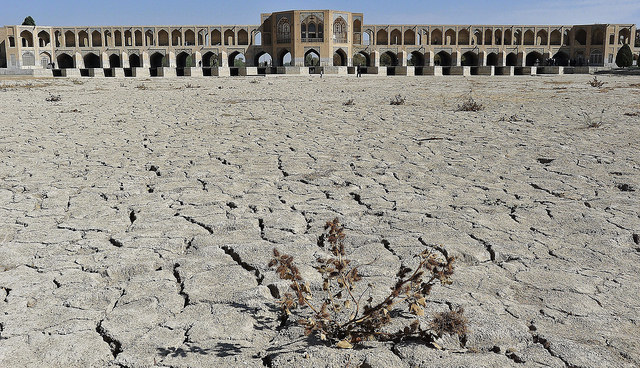
Iran, like much of the Middle East and North Africa, faces a future of extreme weather and drought. Researchers have estimated that temperatures across the region are rising twice as fast as the global average. And ‘wet-bulb temperatures’—a measure of humidity and heat—are predicted to rise so high in the Gulf that the region could be all but uninhabitable by the end of the century.
In addition to rising average temperatures, much of Iran is already facing crisis conditions in its water supply. Iran is predominantly arid or semi-arid, and two-thirds of its rainfall evaporates before it can replenish local river systems. This means that Iran relies on two sources of water: upstream supply of water from neighbours, and subterranean aquifers.
Iran meets over half of its water requirements from aquifers. But its groundwater depletion rate is so high that, at the current rate of usage, 12 of Iran’s 31 provinces will entirely exhaust their aquifers within the next 45 years. Further exacerbating the situation, Iran’s government also predicts a 25% decline in surface water runoff from rainfall and snow melt by 2030.
Iran’s reliance on external sources of water means that it is also vulnerable to developments such as Turkey’s Southeastern Anatolia Project, which involves the construction of 22 dams along the Tigris and Euphrates rivers, and which will dramatically affect the volume of water in the river system.
Like Iraq, Iran has criticised Turkey’s dam project, claiming that it will worsen drought conditions and trigger a major environmental catastrophe in Iran by decreasing water flow by 56% in a river system that’s important to both Iraq and Iran.
Turkey’s dam project isn’t the only regional project that’s threatening Iran’s water security. Afghanistan’s project to build a dam on the Harirud River, which flows from Herat Province into Iran and Turkmenistan, will reduce Iran’s share of the river’s water supply from 30% to 13%. The dam will have a significant impact on Mashhad, Iran’s second largest city, which relies on the river for its water supply. Afghanistan is also pursuing dam-building projects on the Helmand River, which will reduce the water flow into Iran’s Sistan and Baluchistan provinces, both of which are economically poor and already prone to drought and instability.
Given that the effects of these projects are yet to be felt, it’s troubling that water shortages are already fuelling protests in Iran. Since early 2018, grievances over water shortages have led to protests around Isfahan and across eastern Iran. And parallels are being drawn between the current water crisis and drought in Iran and the pre-war situation in Syria, with researchers linking drought to the outbreak of the conflict in Syria.
It’s not surprising that water security is emerging as a flashpoint for conflict between Iran and its neighbours. Iran has acknowledged that water security needs to be addressed cooperatively, but there are signs that there’s more momentum towards conflict than cooperation. For example, Afghanistan has accused Iran of arming and training Taliban groups to sabotage dam and hydro power projects in western and southern Afghanistan.
The reasons for Iran’s water security predicament are varied, and much of the blame can be directed at the government. Population growth, an inefficient and corrupt agricultural sector, and mismanagement of water resources have all combined to undermine Iran’s already fragile water resources.
Iran’s government is alert to the unfolding water crisis—in 2016, former agriculture minister Issa Kalantari noted that if farming practices didn’t change and water consumption for agriculture remained at current levels, up to 50 million people in Iran’s eastern and southern areas would be forced to migrate.
Iran’s parlous water supply situation is also inextricably linked to the broader question of food security. Despite the fact that Iran uses 92% of its water supply for agriculture, it is still reliant on food imports, which account for approximately 34% of its food requirements.
It’s not clear whether Iran has the political will or capacity to implement solutions. The Rouhani government has taken some specific steps to build expertise in water management. Imperial College London’s water conservation expert Kaveh Madani was recruited as deputy head of the Department of the Environment to tackle Iran’s water challenges. However, Madani fled Iran after he was targeted by hardliners. The arrest of 40 environmentalists on spying charges by the Islamic Revolutionary Guards Corp (IRCG) also had a chilling effect on environmental reform.
Even if resistance to reform in the IRCG and other hardline groups could be overcome, the cost of new technologies, conservation practices and other measures to meet projected water needs in 2050 could be as high as US$3 billion a year. Iran will also need to normalise its relations with neighbours, particularly Turkey, Iraq and Afghanistan, if it hopes to secure critical water supply from them through water management agreements.
The great spoiler in all of this is the United States. The doubling down of the Trump administration on the question of regime change in Iran, combined with the re-introduction of punitive sanctions against Iran, dramatically diminishes the prospects for any serious water reform in Iran. The US—in welcoming and even encouraging anti-government protests in Iran—is ignoring the fact that these protests are also often about something much more fundamental than corruption and economic hardship. The re-imposition of broad-based sanctions will also likely limit Iran’s ability to leverage external technical expertise and technologies relevant to best practice in water conservation, and potentially even its capacity to meet a growing shortfall in food supply.
Iran’s water security crisis is a genuine existential threat. If it’s not addressed, Iran may follow Nigeria, Syria and Somalia down the path to civil unrest, mass migration, insurgency or even civil war. It is hard to believe that even the Trump administration would see that as a good outcome.

